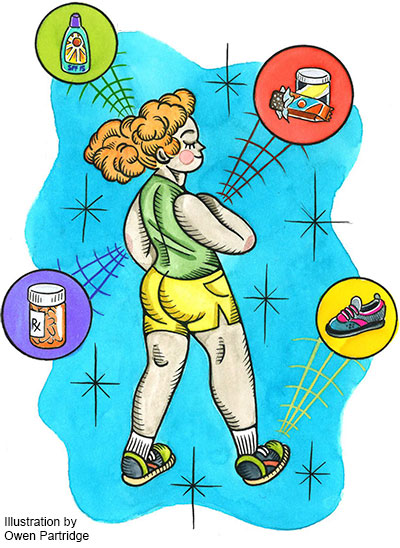Future Now
The IFTF Blog
Bodies that Buy
Could bio-based purchasing bring us closer to our better selves?
Efforts to automate our personal lives are nothing new.
 We use alarm clocks to automate waking up on time; calendar alerts to remind us of meetings; streaming services like Pandora to automatically deliver music tailored just to our preferences. But personal automation isn’t just a matter of convenience; increasingly, we’re learning that automating both big and small decisions can enable us to make decisions that we’re happier with, leaving us feeling more relaxed and able to focus on more important things.
We use alarm clocks to automate waking up on time; calendar alerts to remind us of meetings; streaming services like Pandora to automatically deliver music tailored just to our preferences. But personal automation isn’t just a matter of convenience; increasingly, we’re learning that automating both big and small decisions can enable us to make decisions that we’re happier with, leaving us feeling more relaxed and able to focus on more important things.
THE BIOLOGY OF DECISION-MAKING
In 2007, David Bach published perhaps the best known of a genre of financial planning books based on a very simple strategy: if you set up a direct deposit into your retirement account, you can save without thinking much about it. If you do this year over year for enough time, you can still spend all the money in your bank account—the natural impulse—and set yourself up to become, as the title of the book suggested, an Automatic Millionaire.
Bach’s argument—and the argument of a series of similar books by other authors—is rooted in a growing body of behavioral science research demonstrating that the act of making too many choices exhausts us and leads to worse decisions.
There are physiological markers of reduced decision-making ability: low blood glucose levels lower our abilities to exercise self-control, causing all sorts of unexpected problems.
In one recent study, Ohio State University psychology professor Brad Bushman found that married couples act more aggressively toward each other—by sticking pins into voodoo dolls representing their spouse and blasting them with loud, annoying noises—when they had measurably lower blood glucose levels. In an interview on the study, Bushman advises that, “Something like a protein bar would be a really good thing to have before discussing an important issue with your spouse.”
YOUR BODY IS THE CONTEXT
But what if your body could remind you to eat a protein bar before a tense discussion with a spouse—or a boss?
As the next decade unfolds, our body area networks will take advantage of this new science of decision-making—the biomarkers and personal histories that affect the ways we decide—and remind us to do things like eat protein bars before tense conversations. Our bodies are becoming one of the new frontiers in contextual computing. In much the same way our phones can guide us toward different routes based on traffic patterns, our body area networks will guide us toward different decisions based on the patterns of our biomarkers—altering us when our decision-making ability is impaired or even taking action to get us in a better decision-making mindset.
And as the sensors we use to measure our biomarkers improve, the process for transforming our bodies into a platform for contextual computing will enter a virtuous, accelerating cycle. Most physiological measurements take specialized equipment and are painstakingly slow; for instance, measuring blood glucose involves pricking your finger for blood. The easier it becomes to measure our biomarkers, the better we’ll understand the physiological analogs that shape our behaviors and decisions; the more useful these measures become, the more people will want them.
Food and dieting may be the most obvious domains to use these bio-markers to drive decisions, but they are hardly the only applications. From identifying shoes that fit best and furniture that helps improve posture to streaming media that improves our moods, the potential applications will expand faster and faster as our measurements get better and better.
MARKETING TO BIOMARKERS
 But once we have this internal contextual understanding, what will we want our bodies to communicate? Simply pinging us with more information—in effect a notication presenting yet another decision— would be self-defeating. If our bodies are going to help us make better decisions, we’ll need them to augment the decision-making abilities of our brains. They’ll need to bypass the brain and make decisions on our behalf in much the same way a direct deposit into your retirement account bypasses your consciousness.
But once we have this internal contextual understanding, what will we want our bodies to communicate? Simply pinging us with more information—in effect a notication presenting yet another decision— would be self-defeating. If our bodies are going to help us make better decisions, we’ll need them to augment the decision-making abilities of our brains. They’ll need to bypass the brain and make decisions on our behalf in much the same way a direct deposit into your retirement account bypasses your consciousness.
As radical as it may sound, the idea of adapting the world to our bodies without our knowledge is already gaining traction. Adaptive interface design can now vary how information gets displayed based on a user’s biometrics.
Could the same principle be used to sell us stuff? You bet, but perhaps in ways that remove one more layer of conscious decision-making. The world’s most successful retailers deeply understand the value proposition of convenience. Amazon’s Dash Replenishment Service API is already being built into water filters, ink jet printers, and coffee makers to allow these appliances to directly reorder supplies from Amazon. IBM and Samsung have developed a proof of concept network architecture that enables appliances to pick and choose from trusted vendors to negotiate autonomously for the best deal on the products that you like.
These kinds of systems can be built into our smart watches just as easily as they can be built into our washing machines. In other words, it’s becoming technically feasible to develop systems that allow changes in your body to automatically make purchases on your behalf.
ASPIRATIONS OVER IMPULSES
Whether or not there’s a practical difference in connecting your appliances to a retailer and connecting your body, there’s a dramatic psychological difference. For the vast majority of us, a more convenient way to order coffee won’t be a good enough reason to create a direct connection between our bodies and online retailers.
But what if your body area network could make shopping decisions that support your higher goals? What if it could save you money and help you become an automatic millionaire? What if it could buy foods you want to eat that also make you automatically healthy? Or only make purchases that align with your personal ethics?
Such a system would make this possible, allowing us to make decisions that are dictated more by our aspirations than our impulses. For many people, this, combined with the time and energy saved by outsourcing decisions, could be a sufficiently compelling reason to let our bodies speak for us and buy on our behalf.
 FUTURE NOW—The Complete New Body Language Research Collection
FUTURE NOW—The Complete New Body Language Research Collection
The New Body Language research is collected in its entirety in our inaugural issue of Future Now, IFTF’s new print magazine.
Most pieces in this issue focus on the human side of Human+Machine Symbiosis—how body area networks will augment the intentions and expressions that play out in our everyday lives. Some pieces illuminate the subtle, even invisible technologies that broker our outrageous level of connection—the machines that feed off our passively generated data and varying motivations. Together, they create a portrait of how and why we’ll express ourselves with this new body language in the next decade.
For More Information
For more information on the Tech Futures Lab and our research, contact:
Sean Ness | sness@iftf.org | 650.233.9517



